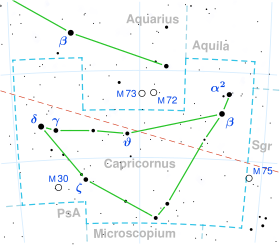Upsilon Capricorni
| Observation data Epoch J2000.0 Equinox J2000.0 (ICRS) | |
|---|---|
| Constellation | Capricornus |
| Right ascension | 20h 40m 02.94518s[1] |
| Declination | −18° 08′ 19.1664″[1] |
| Apparent magnitude (V) | 5.17[2] |
| Characteristics | |
| Spectral type | M1 III[3] |
| B−V color index | +1.65[2] |
| Astrometry | |
| Radial velocity (Rv) | −12.3±1.6[4] km/s |
| Proper motion (μ) | RA: −23.503[1] mas/yr Dec.: −22.157[1] mas/yr |
| Parallax (π) | 4.4702±0.2352 mas[1] |
| Distance | 730 ± 40 ly (220 ± 10 pc) |
| Absolute magnitude (MV) | −1.09[5] |
| Details | |
| Radius | 76.36+8.05 −14.16[1] R☉ |
| Luminosity | 1,283.0±76.5[1] L☉ |
| Temperature | 3,953+427 −193[1] K |
| Metallicity [Fe/H] | −0.08[5] dex |
| Other designations | |
| υ Cap, 15 Capricorni, NSV 25208, BD−18°5738, FK5 773, HD 196777, HIP 101984, HR 7900, SAO 163779[6] | |
| Database references | |
| SIMBAD | data |
Upsilon Capricorni, Latinized from υ Capricorni, is a solitary[7] star in the southern constellation of Capricornus. It has a reddish hue and is dimly visible to the naked eye with an apparent visual magnitude of 5.17.[2] The star is about 730 light years from the Sun based on parallax,[1] but is drifting closer with a radial velocity of −12 km/s.[4] It is 0.22 degree north of the ecliptic, so is subject to lunar occultations.[8][9]
This is an aging red giant star on the asymptotic giant branch[10] with a stellar classification of M1 III,[3] a star that has exhausted the supply of hydrogen at its core then cooled and expanded. At present it has 76[1] times the radius of the Sun. It is a suspected variable star of unknown type with a brightness that has been measured ranging from a peak of 5.19 down to 5.24.[11] The star is radiating 1,283[1] times the luminosity of the Sun from its swollen photosphere at an effective temperature of 3,953 K.[1]
References
[edit]- ^ a b c d e f g h i j k l Brown, A. G. A.; et al. (Gaia collaboration) (August 2018). "Gaia Data Release 2: Summary of the contents and survey properties". Astronomy & Astrophysics. 616. A1. arXiv:1804.09365. Bibcode:2018A&A...616A...1G. doi:10.1051/0004-6361/201833051. Gaia DR2 record for this source at VizieR.
- ^ a b c Barnes, T. G.; et al. (May 1978), "Stellar angular diameters and visual surface brightness. III - an improved definition of the relationship", Monthly Notices of the Royal Astronomical Society, 183 (3): 285–304, Bibcode:1978MNRAS.183..285B, doi:10.1093/mnras/183.3.285.
- ^ a b Houk, N.; Smith-Moore, M. (1988), Michigan Catalogue of Two-dimensional Spectral Types for the HD Stars, vol. 4, Bibcode:1988mcts.book.....H.
- ^ a b Gontcharov, G. A. (November 2006), "Pulkovo Compilation of Radial Velocities for 35495 Hipparcos stars in a common system", Astronomy Letters, 32 (11): 759–771, arXiv:1606.08053, Bibcode:2006AstL...32..759G, doi:10.1134/S1063773706110065, S2CID 119231169.
- ^ a b Anderson, E.; Francis, Ch. (2012), "XHIP: An extended hipparcos compilation", Astronomy Letters, 38 (5): 331, arXiv:1108.4971, Bibcode:2012AstL...38..331A, doi:10.1134/S1063773712050015, S2CID 119257644.
- ^ "* ups Cap". SIMBAD. Centre de données astronomiques de Strasbourg. Retrieved 2017-05-12.
- ^ Eggleton, P. P.; Tokovinin, A. A. (September 2008), "A catalogue of multiplicity among bright stellar systems", Monthly Notices of the Royal Astronomical Society, 389 (2): 869–879, arXiv:0806.2878, Bibcode:2008MNRAS.389..869E, doi:10.1111/j.1365-2966.2008.13596.x, S2CID 14878976.
- ^ White, Nathaniel M.; Feierman, Barry H. (September 1987), "A Catalog of Stellar Angular Diameters Measured by Lunar Occultation", Astronomical Journal, 94: 751, Bibcode:1987AJ.....94..751W, doi:10.1086/114513.
- ^ Dunham, D. W.; Evans, D. S.; Silverberg, E. C.; Wiant, J. R. (March 1973), "The angular diameter of Upsilon Capricorni and an occultation of SAO 118655.", Astronomical Journal, 78: 199–201, Bibcode:1973AJ.....78..199D, doi:10.1086/111398.
- ^ Eggen, Olin J. (July 1992), "Asymptotic giant branch stars near the sun", Astronomical Journal, 104 (1): 275–313, Bibcode:1992AJ....104..275E, doi:10.1086/116239.
- ^ Samus, N. N.; et al. (2017), "General Catalogue of Variable Stars", Astronomy Reports, 5.1, 61 (1): 80–88, Bibcode:2017ARep...61...80S, doi:10.1134/S1063772917010085, S2CID 125853869.

